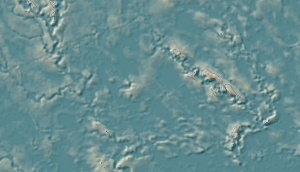Groundwater
Target groundwater separation[edit]
In many areas of Ontario the target separation between the base of an exfiltrating LID practice and the water table is 1.0 m. This is to mitigate risks due to short periods of groundwater mounding and potentially unobserved seasonal fluctuations. In areas where a 1.0 m separation cannot be provided, or where conditions dictate that an even greater separation may be warranted, additional discussion and/or analysis specific to the physical characteristics of the site and the proposed design should be completed. The design practitioner is advised to consult with approval agencies to understand their requirements and/or expectations prior to undertaking work, and to complete an appropriate level of analysis to support their conclusion. The requirement for additional investigation and/or documentation supporting a proposed design may be reduced in areas where ≥ 1.0 m separation is anticipated.
Retention of an unsaturated zone beneath the practice :
- Minimizes the potential for functional impacts associated with reduced percolation rates,
- Maintains the physical and biochemical water quality treatment benefits provided within the vadose zone.
Groundwater mounding[edit]
Groundwater mounding describes the localised raising of the water table beneath infiltration practices. It may be of concern if it affects nearby structures including building foundations. When you wish to model the extent of groundwater mounding beneath an infiltration facility, use this Tool that incorporates Hantush's derivation (1967).
Note that this is a minor adaptation (metric units and formatting) from the original tool, written and hosted by the USGS.
Preventing groundwater interaction[edit]
Many LID systems rely upon reuse, or evaporation and transpiration instead of infiltration to the ground. If the site cannot support any infiltration, consider
Oak Ridges Moraine Groundwater Program[edit]
The Oak Ridges Moraine Groundwater Program works collaboratively with government agencies and consultants to better understand and manage the water resources of the Oak Ridges Moraine physiographic region, which stretches from the Credit and Nottawasaga River watersheds in the west, to the Trent River in the east and reaches from the shores of Lake Ontario northwards to Lake Simcoe and the Kawartha Lakes watersheds. The program delivers a multi-agency collaborative approach to collecting, analyzing and disseminating geological and hydrogeological knowledge as a basis for effective decision making and stewardship of water resources in this part of Ontario. Visit the program website to learn more about program elements and publications. Through the publicly accessible maps portion of the program website users have the ability to generate maps of estimated water table elevation and depth to water table for sites captured by the regional groundwater model and locate existing well and borehole records. This provides LID designers with a powerful tool for identifying opportunities for, and constraints to implementating stormwater infiltration facilities with regard to groundwater levels.
